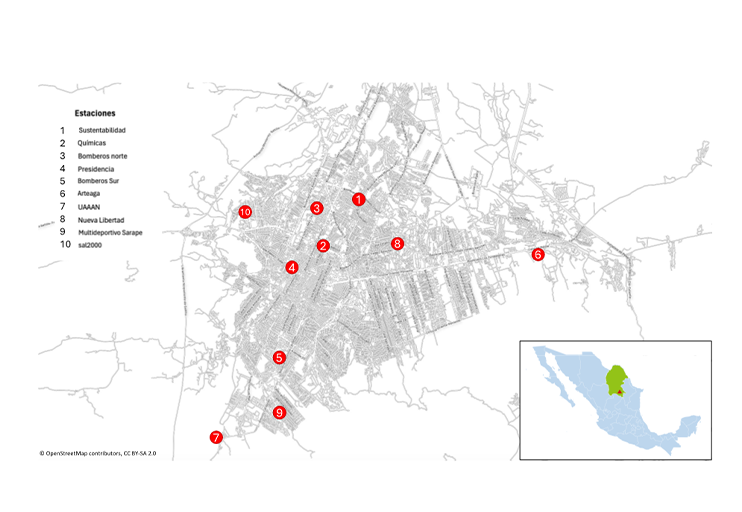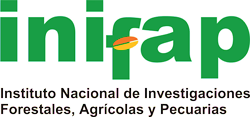Influence of meteorological variables on PM2.5 concentration in Saltillo
DOI:
https://doi.org/10.29312/remexca.v16i30.4045Keywords:
air quality, boundary layer, particulate matter, pollutionAbstract
The present work studied the relationship of meteorological conditions with the concentration of particulate matter with a diameter equal to or less than 2.5 μm (PM2.5) in the city of Saltillo, Coahuila, intending to identify the areas and times with the highest levels of pollution. Data on temperature, wind speed, relative humidity, solar radiation, and atmospheric pressure, as well as the daily concentration of PM2.5 particles, were collected through a network of ten air quality monitoring sensors and two atmospheric observatories, distributed throughout the city, during 2024. First, the data from the sensor network were analyzed, revealing that the Pearson coefficient showed a high or moderate correlation between the concentration recorded by the sensors, regardless of location, and that the West Zone presented the most days with low air quality. Subsequently, the data from the observatories were analyzed to relate meteorological conditions with daily average PM2.5 concentrations, and according to the behavior of PM2.5 per hour, it was found that meteorological factors do not present a significant relationship with PM2.5 concentration, when compared with the daily average; nevertheless, when the concentration throughout the day was observed, a relationship with atmospheric parameters was found.
Downloads
References
Akinwumiju, A. S.; Ajisafe, T. and Adelodun, A. A. 2021. Airborne particulate matter pollution in Akure metro city, Southwestern Nigeria, West Africa: attribution and meteorological influence. Journal of Geovisualization and Spatial Analysis. 5(1):01–17. https://doi.org/10.1007/s41651-021-00079-6.
Akpinar, S.; Oztop, H. F. and Akpinar, E. K. 2008. Evaluation of relationship between meteorological parameters and air pollutant concentrations during winter season in Elaziǧ, Turkey. Environmental Monitoring and Assessment. 146(1-3):211-224. https://doi.org/10.1007/s10661-007-0073-9.
Al Jallad, F. A.; Al Katheeri, E. A. and Al Omar, M. A. 2013. Concentrations of particulate matter and their relationships with meteorological variables. Sustainable Environment Research. 23(3):191-198.
Whiteman, C. D. 1982. Breakup of temperature inversions in deep mountain valleys: Part I. Observations. Journal of Applied Meteorology and Climatology, 21(3):270-289.
Galindo, N.; Varea, M.; Gil-Moltó, J.; Yubero, E. and Nicolás, J. 2011. The influence of meteorology on particulate matter concentrations at an urban mediterranean location. Water, Air and Soil Pollution. 215(1-4):365-372. https://doi.org/10.1007/s11270-010-0484-z.
Hama, S. M. L.; Kumar, P.; Harrison, R. M.; Bloss, W. J.; Khare, M.; Mishra, S.; Namdeo, A.; Sokhi, R.; Goodman, P. and Sharma, C. 2020. Four-year assessment of ambient particulate matter and trace gases in the Delhi-NCR region of India. Sustainable Cities and Society. 54:102003. https://doi.org/10.1016/j.scs.2019.102003.
Islam, Md. R.; Jayarathne, T.; Simpson, I. J.; Werden, B.; Maben, J.; Gilbert, A.; Praveen, P. S.; Adhikari, S.; Panday, A. K.; Rupakheti, M.; Blake, D. R.; Yokelson, R. J.; Decarlo, P. F.; Keene, W. C. and Stone, E. A. 2020. Ambient air quality in the Kathmandu Valley, Nepal, during the pre-monsoon: concentrations and sources of particulate matter and trace gases. Atmospheric Chemistry and Physics. 20(5):2927-2951. https://doi.org/10.5194/acp-20-2927-2020.
Kartal, S. and Özer, U. 1998. Determination and parameterization of some air pollutants as a function of meteorological parameters in Kayseri, Turkey. Journal of the Air and Waste Management Association. 48(9):853-859. https://doi.org/10.1080/10473289.1998.10463738.
Marsh, K. J. and Foster, M. D. 1967. An experimental study of the dispersion of emissions from chimneys in Reading-I: The study of long-term average concentrations of sulphur dioxide. Atmospheric Environment. 1(5):527-550.
Mendoza, H. J. M. 2017. Diagnóstico climático para la zona de influencia inmediata de la UAAAN. Boletín Agrometeorológico. 99-100 pp.
Oguz, E.; Kaya, M. D. and Nuhoglu, Y. 2003. Interaction between air pollution and meteorological parameters in Erzurum, Turkey. In Int. J. Environment and pollution. 19(3):292-300.
Savov, P. B.; Skakalova, T. S.; Kolev, I. N. and Ludwig, F. L. 2000. Lidar investigation of the temporal and spatial distribution of atmospheric aerosols in mountain valleys. Journal of Applied Meteorology. 41(5):528-541. https://doi.org/10.1175/1520-0450(2002)041<0528:LIOTTA>2.0.CO;2.
Tai, A. P. K.; Mickley, L. J. and Jacob, D. J. 2010. Correlations between fine particulate matter (PM2.5) and meteorological variables in the United States: implications for the sensitivity of PM2.5 to climate change. Atmospheric Environment. 44(32):3976-3984. https://doi.org/https://doi.org/10.1016/j.atmosenv.2010.06.060.
Mendoza, U. I. y Vázquez, Z. M. A. 2017. Detección de extremos climáticos de precipitación y temperatura en el estado de Guerrero. 21(1):13-30.
West, J. J.; Cohen, A.; Dentener, F.; Brunekreef, B.; Zhu, T.; Armstrong, B.; Bell, M. L.; Brauer, M.; Carmichael, G.; Costa, D. L.; Dockery, D. W.; Kleeman, M.; Krzyzanowski, M.; Künzli, N.; Liousse, C.; Lung, S. C. C.; Martin, R. V.; Pöschl, U.; Pope, C. A. and Wiedinmyer, C. 2016. What we breathe impacts our health: improving understanding of the link between air pollution and health. Environmental Science and Technology. 50(10):4895-4904. https://doi.org/10.1021/acs.est.5b03827.
Xu, Y; Xue, W.; Lei, Y.; Huang, Q.; Zhao, Y.; Cheng, S.; Ren, Z. and Wang, J. 2020. Spatiotemporal variation in the impact of meteorological conditions on PM2.5 pollution in China from 2000 to 2017. Atmospheric Environment. 223:117215. https://doi.org/https://doi.org/10.1016/j.atmosenv.2019.117215.
Xu, J.; Yan, F.; Xie, Y.; Wang, F.; Wu, J. and Fu, Q. 2015. Impact of meteorological conditions on a nine-day particulate matter pollution event observed in December 2013 shanghai, China. Particuology. 20:69-79. https://doi.org/10.1016/j.partic.2014.09.001.
Yadav, S.; Praveen, O. D. and Satsangi, P. G. 2015. The effect of climate and meteorological changes on particulate matter in Pune, India. Environmental Monitoring and Assessment. 187(7):402. https://doi.org/10.1007/s10661-015-4634-z.
Yangyang, X.; Bin, Z.; Lin, Z. and Rong, L. 2015. Spatiotemporal variations of PM2.5 and PM10 concentrations between 31 Chinese cities and their relationships with SO2, NO2, CO and O3. Particuology. 20:141-149. https://doi.org/10.1016/j.partic.2015.01.003.
Zender-Świercz, E.; Galiszewska, B.; Telejko, M. and Starzomska, M. 2024. The effect of temperature and humidity of air on the concentration of particulate matter - PM2.5 and PM10. Atmospheric Research. 312:107733. https://doi.org/10.1016/j.atmosres.2024.107733.
Zhao, S.; Yu, Y.; Yin, D.; He, J.; Liu, N.; Qu, J. and Xiao, J. 2016. Annual and diurnal variations of gaseous and particulate pollutants in 31 provincial capital cities based on in situ air quality monitoring data from China national environmental monitoring center. Environment International. 82:92-106. https://doi.org/10.1016/j.envint.2015.11.003.

Published
How to Cite
Issue
Section
License
Copyright (c) 2025 Revista Mexicana de Ciencias Agrícolas

This work is licensed under a Creative Commons Attribution-NonCommercial 4.0 International License.
The authors who publish in Revista Mexicana de Ciencias Agrícolas accept the following conditions:
In accordance with copyright laws, Revista Mexicana de Ciencias Agrícolas recognizes and respects the authors’ moral right and ownership of property rights which will be transferred to the journal for dissemination in open access. Invariably, all the authors have to sign a letter of transfer of property rights and of originality of the article to Instituto Nacional de Investigaciones Forestales, Agrícolas y Pecuarias (INIFAP) [National Institute of Forestry, Agricultural and Livestock Research]. The author(s) must pay a fee for the reception of articles before proceeding to editorial review.
All the texts published by Revista Mexicana de Ciencias Agrícolas —with no exception— are distributed under a Creative Commons License Attribution-NonCommercial 4.0 International (CC BY-NC 4.0), which allows third parties to use the publication as long as the work’s authorship and its first publication in this journal are mentioned.
The author(s) can enter into independent and additional contractual agreements for the nonexclusive distribution of the version of the article published in Revista Mexicana de Ciencias Agrícolas (for example include it into an institutional repository or publish it in a book) as long as it is clearly and explicitly indicated that the work was published for the first time in Revista Mexicana de Ciencias Agrícolas.
For all the above, the authors shall send the Letter-transfer of Property Rights for the first publication duly filled in and signed by the author(s). This form must be sent as a PDF file to: revista_atm@yahoo.com.mx; cienciasagricola@inifap.gob.mx; remexca2017@gmail.
This work is licensed under a Creative Commons Attribution-Noncommercial 4.0 International license.


